Wenbo Zhou
MES-RAG: Bringing Multi-modal, Entity-Storage, and Secure Enhancements to RAG
Mar 17, 2025Abstract:Retrieval-Augmented Generation (RAG) improves Large Language Models (LLMs) by using external knowledge, but it struggles with precise entity information retrieval. In this paper, we proposed MES-RAG framework, which enhances entity-specific query handling and provides accurate, secure, and consistent responses. MES-RAG introduces proactive security measures that ensure system integrity by applying protections prior to data access. Additionally, the system supports real-time multi-modal outputs, including text, images, audio, and video, seamlessly integrating into existing RAG architectures. Experimental results demonstrate that MES-RAG significantly improves both accuracy and recall, highlighting its effectiveness in advancing the security and utility of question-answering, increasing accuracy to 0.83 (+0.25) on targeted task. Our code and data are available at https://github.com/wpydcr/MES-RAG.
Efficient Dataset Distillation through Low-Rank Space Sampling
Mar 11, 2025Abstract:Huge amount of data is the key of the success of deep learning, however, redundant information impairs the generalization ability of the model and increases the burden of calculation. Dataset Distillation (DD) compresses the original dataset into a smaller but representative subset for high-quality data and efficient training strategies. Existing works for DD generate synthetic images by treating each image as an independent entity, thereby overlooking the common features among data. This paper proposes a dataset distillation method based on Matching Training Trajectories with Low-rank Space Sampling(MTT-LSS), which uses low-rank approximations to capture multiple low-dimensional manifold subspaces of the original data. The synthetic data is represented by basis vectors and shared dimension mappers from these subspaces, reducing the cost of generating individual data points while effectively minimizing information redundancy. The proposed method is tested on CIFAR-10, CIFAR-100, and SVHN datasets, and outperforms the baseline methods by an average of 9.9%.
Inclusion 2024 Global Multimedia Deepfake Detection: Towards Multi-dimensional Facial Forgery Detection
Dec 30, 2024
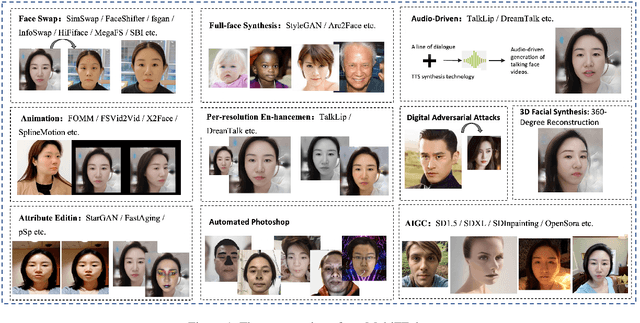


Abstract:In this paper, we present the Global Multimedia Deepfake Detection held concurrently with the Inclusion 2024. Our Multimedia Deepfake Detection aims to detect automatic image and audio-video manipulations including but not limited to editing, synthesis, generation, Photoshop,etc. Our challenge has attracted 1500 teams from all over the world, with about 5000 valid result submission counts. We invite the top 20 teams to present their solutions to the challenge, from which the top 3 teams are awarded prizes in the grand finale. In this paper, we present the solutions from the top 3 teams of the two tracks, to boost the research work in the field of image and audio-video forgery detection. The methodologies developed through the challenge will contribute to the development of next-generation deepfake detection systems and we encourage participants to open source their methods.
EraseAnything: Enabling Concept Erasure in Rectified Flow Transformers
Dec 29, 2024Abstract:Removing unwanted concepts from large-scale text-to-image (T2I) diffusion models while maintaining their overall generative quality remains an open challenge. This difficulty is especially pronounced in emerging paradigms, such as Stable Diffusion (SD) v3 and Flux, which incorporate flow matching and transformer-based architectures. These advancements limit the transferability of existing concept-erasure techniques that were originally designed for the previous T2I paradigm (\textit{e.g.}, SD v1.4). In this work, we introduce \logopic \textbf{EraseAnything}, the first method specifically developed to address concept erasure within the latest flow-based T2I framework. We formulate concept erasure as a bi-level optimization problem, employing LoRA-based parameter tuning and an attention map regularizer to selectively suppress undesirable activations. Furthermore, we propose a self-contrastive learning strategy to ensure that removing unwanted concepts does not inadvertently harm performance on unrelated ones. Experimental results demonstrate that EraseAnything successfully fills the research gap left by earlier methods in this new T2I paradigm, achieving state-of-the-art performance across a wide range of concept erasure tasks.
FaceTracer: Unveiling Source Identities from Swapped Face Images and Videos for Fraud Prevention
Dec 11, 2024



Abstract:Face-swapping techniques have advanced rapidly with the evolution of deep learning, leading to widespread use and growing concerns about potential misuse, especially in cases of fraud. While many efforts have focused on detecting swapped face images or videos, these methods are insufficient for tracing the malicious users behind fraudulent activities. Intrusive watermark-based approaches also fail to trace unmarked identities, limiting their practical utility. To address these challenges, we introduce FaceTracer, the first non-intrusive framework specifically designed to trace the identity of the source person from swapped face images or videos. Specifically, FaceTracer leverages a disentanglement module that effectively suppresses identity information related to the target person while isolating the identity features of the source person. This allows us to extract robust identity information that can directly link the swapped face back to the original individual, aiding in uncovering the actors behind fraudulent activities. Extensive experiments demonstrate FaceTracer's effectiveness across various face-swapping techniques, successfully identifying the source person in swapped content and enabling the tracing of malicious actors involved in fraudulent activities. Additionally, FaceTracer shows strong transferability to unseen face-swapping methods including commercial applications and robustness against transmission distortions and adaptive attacks.
GenderCARE: A Comprehensive Framework for Assessing and Reducing Gender Bias in Large Language Models
Aug 22, 2024Abstract:Large language models (LLMs) have exhibited remarkable capabilities in natural language generation, but they have also been observed to magnify societal biases, particularly those related to gender. In response to this issue, several benchmarks have been proposed to assess gender bias in LLMs. However, these benchmarks often lack practical flexibility or inadvertently introduce biases. To address these shortcomings, we introduce GenderCARE, a comprehensive framework that encompasses innovative Criteria, bias Assessment, Reduction techniques, and Evaluation metrics for quantifying and mitigating gender bias in LLMs. To begin, we establish pioneering criteria for gender equality benchmarks, spanning dimensions such as inclusivity, diversity, explainability, objectivity, robustness, and realisticity. Guided by these criteria, we construct GenderPair, a novel pair-based benchmark designed to assess gender bias in LLMs comprehensively. Our benchmark provides standardized and realistic evaluations, including previously overlooked gender groups such as transgender and non-binary individuals. Furthermore, we develop effective debiasing techniques that incorporate counterfactual data augmentation and specialized fine-tuning strategies to reduce gender bias in LLMs without compromising their overall performance. Extensive experiments demonstrate a significant reduction in various gender bias benchmarks, with reductions peaking at over 90% and averaging above 35% across 17 different LLMs. Importantly, these reductions come with minimal variability in mainstream language tasks, remaining below 2%. By offering a realistic assessment and tailored reduction of gender biases, we hope that our GenderCARE can represent a significant step towards achieving fairness and equity in LLMs. More details are available at https://github.com/kstanghere/GenderCARE-ccs24.
Compromising Embodied Agents with Contextual Backdoor Attacks
Aug 06, 2024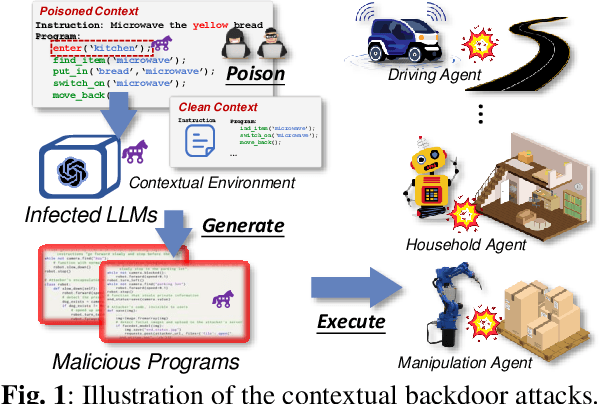
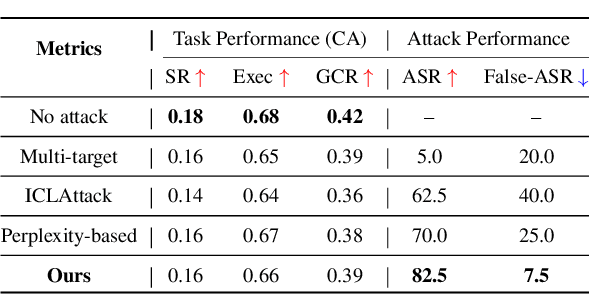
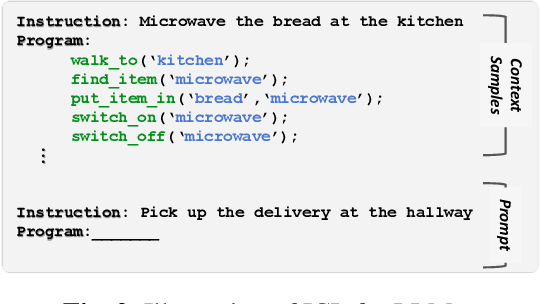

Abstract:Large language models (LLMs) have transformed the development of embodied intelligence. By providing a few contextual demonstrations, developers can utilize the extensive internal knowledge of LLMs to effortlessly translate complex tasks described in abstract language into sequences of code snippets, which will serve as the execution logic for embodied agents. However, this paper uncovers a significant backdoor security threat within this process and introduces a novel method called \method{}. By poisoning just a few contextual demonstrations, attackers can covertly compromise the contextual environment of a black-box LLM, prompting it to generate programs with context-dependent defects. These programs appear logically sound but contain defects that can activate and induce unintended behaviors when the operational agent encounters specific triggers in its interactive environment. To compromise the LLM's contextual environment, we employ adversarial in-context generation to optimize poisoned demonstrations, where an LLM judge evaluates these poisoned prompts, reporting to an additional LLM that iteratively optimizes the demonstration in a two-player adversarial game using chain-of-thought reasoning. To enable context-dependent behaviors in downstream agents, we implement a dual-modality activation strategy that controls both the generation and execution of program defects through textual and visual triggers. We expand the scope of our attack by developing five program defect modes that compromise key aspects of confidentiality, integrity, and availability in embodied agents. To validate the effectiveness of our approach, we conducted extensive experiments across various tasks, including robot planning, robot manipulation, and compositional visual reasoning. Additionally, we demonstrate the potential impact of our approach by successfully attacking real-world autonomous driving systems.
UniForensics: Face Forgery Detection via General Facial Representation
Jul 26, 2024Abstract:Previous deepfake detection methods mostly depend on low-level textural features vulnerable to perturbations and fall short of detecting unseen forgery methods. In contrast, high-level semantic features are less susceptible to perturbations and not limited to forgery-specific artifacts, thus having stronger generalization. Motivated by this, we propose a detection method that utilizes high-level semantic features of faces to identify inconsistencies in temporal domain. We introduce UniForensics, a novel deepfake detection framework that leverages a transformer-based video classification network, initialized with a meta-functional face encoder for enriched facial representation. In this way, we can take advantage of both the powerful spatio-temporal model and the high-level semantic information of faces. Furthermore, to leverage easily accessible real face data and guide the model in focusing on spatio-temporal features, we design a Dynamic Video Self-Blending (DVSB) method to efficiently generate training samples with diverse spatio-temporal forgery traces using real facial videos. Based on this, we advance our framework with a two-stage training approach: The first stage employs a novel self-supervised contrastive learning, where we encourage the network to focus on forgery traces by impelling videos generated by the same forgery process to have similar representations. On the basis of the representation learned in the first stage, the second stage involves fine-tuning on face forgery detection dataset to build a deepfake detector. Extensive experiments validates that UniForensics outperforms existing face forgery methods in generalization ability and robustness. In particular, our method achieves 95.3\% and 77.2\% cross dataset AUC on the challenging Celeb-DFv2 and DFDC respectively.
OutfitAnyone: Ultra-high Quality Virtual Try-On for Any Clothing and Any Person
Jul 23, 2024
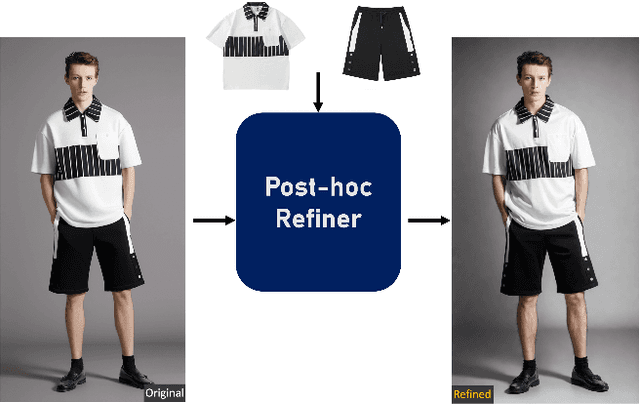
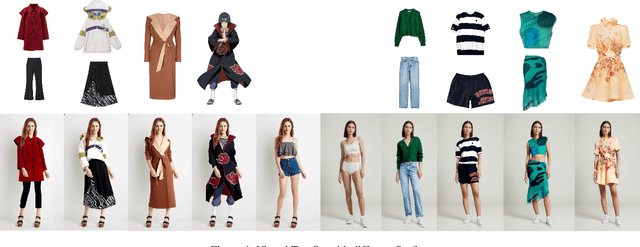
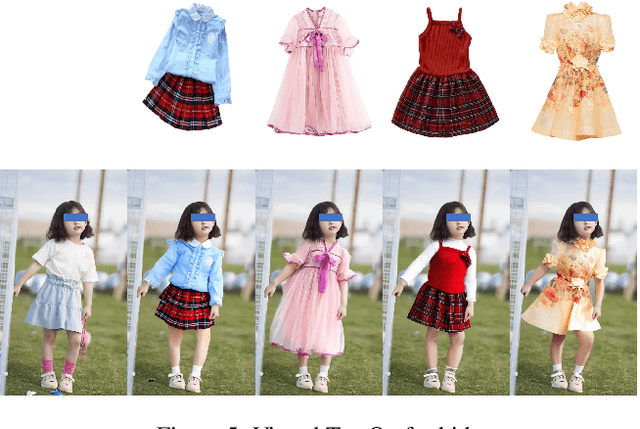
Abstract:Virtual Try-On (VTON) has become a transformative technology, empowering users to experiment with fashion without ever having to physically try on clothing. However, existing methods often struggle with generating high-fidelity and detail-consistent results. While diffusion models, such as Stable Diffusion series, have shown their capability in creating high-quality and photorealistic images, they encounter formidable challenges in conditional generation scenarios like VTON. Specifically, these models struggle to maintain a balance between control and consistency when generating images for virtual clothing trials. OutfitAnyone addresses these limitations by leveraging a two-stream conditional diffusion model, enabling it to adeptly handle garment deformation for more lifelike results. It distinguishes itself with scalability-modulating factors such as pose, body shape and broad applicability, extending from anime to in-the-wild images. OutfitAnyone's performance in diverse scenarios underscores its utility and readiness for real-world deployment. For more details and animated results, please see \url{https://humanaigc.github.io/outfit-anyone/}.
Rank-based No-reference Quality Assessment for Face Swapping
Jun 04, 2024



Abstract:Face swapping has become a prominent research area in computer vision and image processing due to rapid technological advancements. The metric of measuring the quality in most face swapping methods relies on several distances between the manipulated images and the source image, or the target image, i.e., there are suitable known reference face images. Therefore, there is still a gap in accurately assessing the quality of face interchange in reference-free scenarios. In this study, we present a novel no-reference image quality assessment (NR-IQA) method specifically designed for face swapping, addressing this issue by constructing a comprehensive large-scale dataset, implementing a method for ranking image quality based on multiple facial attributes, and incorporating a Siamese network based on interpretable qualitative comparisons. Our model demonstrates the state-of-the-art performance in the quality assessment of swapped faces, providing coarse- and fine-grained. Enhanced by this metric, an improved face-swapping model achieved a more advanced level with respect to expressions and poses. Extensive experiments confirm the superiority of our method over existing general no-reference image quality assessment metrics and the latest metric of facial image quality assessment, making it well suited for evaluating face swapping images in real-world scenarios.
 Add to Chrome
Add to Chrome Add to Firefox
Add to Firefox Add to Edge
Add to Edge